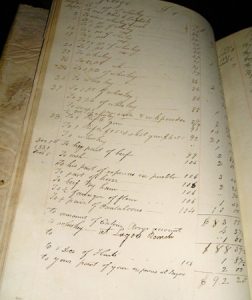
Traveler: William Wolfskill
When and Where: William Wolfskill’s expedition in 1830-1831 was among the first to travel almost the entire length of the Northern Route of the Old Spanish Trail, which became the Main Route over time
Submitted by: Conchita Thornton Marusich, Napa California
Relationship: William Wolfskill was my great-great-grandfather

William Wolfskill, my great-great-grandfather, was a trailblazer over the Old Spanish Trail. He was born in Madison County, Kentucky in 1798. In 1809, the Wolfskill family moved west where William grew up on the Missouri frontier. In 1822, he traveled with William Becknell’s second expedition over the Santa Fe Trail and almost died crossing the Journey of Death desert in Kansas. Desperately thirsty, he was saved by drinking water from the stomach of a dead buffalo that the members of the expedition had just found and killed. One trapper years later described it as “filthy” water that was an “exquisite delight” since it had saved their lives.
William became a mountain man and trapped for beaver in New Mexico alongside famous trappers like Peg-leg Smith and Ewing Young. He also was granted Mexican citizenship in Taos, New Mexico. In September of 1830, the Wolfskill expedition left Abiquiu, New Mexico with a group of trappers including George Yount- a friend from the Missouri frontier. They were headed to California. They traveled into southern Colorado and up to the Green River in present-day Utah.
Their journey over the Old Spanish Trail included many challenging and exciting times. In Utah, they encountered a funeral for a Ute Indian Chief. When the trappers showed great respect during the ceremony, the Utes promised them protection from harm while traveling on their land. At Clear Creek, the expedition took the wrong turn and traveled south. They nearly perished in a brutal snowstorm in the mountains near present-day Panguitch, Utah. The trappers placed beaver skins and woolen blankets over the snow and huddled with their animals for warmth to survive the intense snowstorm.
After they descended from the mountains, they may have camped north of present-day Cedar City, Utah. In Braffits Canyon, there is a boulder with the year “1831” inscribed on the rock which appears to be from the Wolfskill expedition.

Towards the end of their journey, the Wolfskill party arrived at the Mojave Indian Villages. Because of past conflicts with other trapper groups, William ordered a swivel gun to be mounted on a mule in case of problems. Instead the Mojave Indians were friendly and gave the trappers corn bread, dried pumpkin and white beans.
Arriving in San Gabriel, California in February 1831, William decided to settle in the Pueblo de Los Angeles instead of returning to New Mexico. He became a successful farmer and established the famous Wolfskill citrus orchards and vineyards. William was also the owner of Rancho Rio de los Putos located in present-day Winters, in Northern California along with his brother, John Reid Wolfskill. William sent John Reid citrus seedlings, corn, beans, vine cuttings, shovels and brandy from his farm in Los Angeles. Eventually Rancho Rio de los Putos was entirely owned by John Reid who also became a very well-known farmer in Northern California.
By 1862, William Wolfskill’s orchards in Los Angeles had two thirds of California’s orange trees. He is recognized as the founder of the California commercial citrus industry and is seen as an important figure in the California wine business.
William lived through tumultuous times as Los Angeles changed from a small Mexican settlement into an American town after the Mexican-American War. During those transition years, he served as a bridge between the old California under Mexico and the emerging California under the United States.

Your interest: I became interested in my great-great-grandfather because he was a legend in our family. My mother often told me stories about William, Los Angeles and California when I was growing up.
Where did he settle: William Wolfskill settled in El Pueblo de Los Angeles
Unique story or fact: My husband, Rich, and I spent over ten years researching William Wolfskill’s life. We retraced William Wolfskill’s footsteps through Kentucky, Missouri, Kansas, Oklahoma, New Mexico, Utah, Nevada and California.
We traveled over the Old Spanish Trail as well as the Santa Fe Trail many times because we wanted to meet William in his environment, which meant going to where he had lived, trapped and traveled.
Throughout our research, I was able to dig deeply into my family’s roots and find pieces of my genealogical puzzle. I finally wrote a book about William called In Search of William Wolfskill: Journey to Find the Legacy, which describes William’s life as well as our journey of exploration and self-discovery.
 |
 On the Trail to Castle Dale, Utah. This photo was taken during our first journey over the Old Spanish Trail in 2006. Courtesy of Conchita Thornton Marusich |
| Rich and Conchita Marusich standing in front of an old orange tree at Wolfskill Experimental Farm in Winters, California which may have come from William Wolfskill’s orchard in Los Angeles. The Wolfskill Experimental Farm is California Registered Historical Landmark 804. Courtesy of Richard Marusich |
Sources: My major sources for William’s trip on the Old Spanish Trail:
Barrows, H.D. “William Wolfskill, The Pioneer.” Annual Publications, Historical Society of Southern California. (1902): 287-
294.
Camp, Charles L., ed. George C. Yount and his Chronicles of the West. Denver: Old West Publishing Company, 1966. George Yount told Reverend Clark his story in 1854-55.
Day, F.H. “Ziba Branch.” The Hesperian. Vol. lll, (1859): 337-339.
Hafen, Leroy R. and Ann W. Hafen. Old Spanish Trail: Santa Fe to Los Angeles. Arthur H. Clark Company, 1954. Reprint, University of Nebraska Press, 1993.
Wilson, Iris Higbie. William Wolfskill 1798-1866: Frontier Trapper to California Ranchero. Glendale: The Arthur H. Clark Company, 1965.
Wolfskill, William. Ledger of Accounts 1830-1832. Photocopy, Huntington Library and Wolfskill Family.
